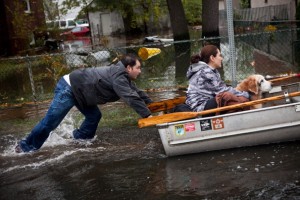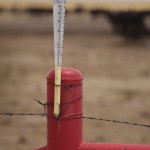3 Ways Climate Change Made Hurricane Sandy Worse

Photo by Andrew Burton/Getty Images
A man pushes a woman and a dog in a boat a boat after their neighborhood experienced flooding due to Hurricane Sandy, on October 30, 2012, in Little Ferry, New Jersey.
It’s tempting to look at a colossal storm like Sandy — the lives lost, the millions without power — and lay the blame completely on climate change. But Dr. Katharine Hayhoe, director of the Climate Science Center at Texas Tech University, says it’s not that simple.
“We can never say one specific event is because of climate change, but what we can say is that climate change has altered the background conditions over which these events occur,” Hayhoe tells us. A hurricane at this time of year, for instance, isn’t highly unusual. She says it happens about once every ten years.
“But what is unusual about Sandy is the size, the strength, and the pathway or trajectory it followed,” Hayhoe says. The first, and most obvious, climate change factor that exacerbated Sandy was a rise in sea levels:
- Sea Level Rise: Hayhoe says that on average, sea levels have gone up about seven inches in the last hundred years in the U.S. because of climate change. “So when any hurricane occurs, you now have an extra seven inches of height on the storm surges,” Hayhoe says. That can flood an otherwise safe street, or topple a sea wall or levee that would normally hold.
-

Photo courtesy of Texas Tech University
Dr. Katharine Hayhoe says climate change didn't cause Hurricane Sandy, but it did make it worse.
Higher Sea Surface Temperatures: “Hurricanes get their power, or their energy, from warm ocean waters,” Hayhoe says. “And as the planet warms, ocean temperatures have also been warming.” Off the coast where Sandy struck this week, October surface ocean temperatures have warmed by two degrees over the last hundred years, Hayhoe says. “So when any given hurricane comes along, on average there’s warmer water than there would have been otherwise,” she notes. “Which gives it more energy, and gives it more strength.” Hayhoe says it’s impossible to define exactly how much stronger Sandy was because of those warmer temperatures, but we know “it’s more than zero.”
- Melting Arctic Ice: Here’s where things get interesting, according to Hayhoe. “We are just beginning to understand right now how climate change can alter our weather patterns,” Hayhoe says. This year was a big year for sea ice loss, with records smashed in September. “So the Arctic is unusually warm,” Hayhoe says. “It very likely affects the trajectory of our jet streams, where it guides hurricanes and other storm systems, it also effects where our high and low pressure systems occur.” The fact that Sandy took an unprecedented sharp left turn towards the coast, Hayhoe says, instead of heading out to sea like every other “self-respecting” hurricane, “really raises our suspicions that something unusual was going on.” Hayhoe says scientists aren’t sure yet what it was that guided Sandy ashore, but “they’re putting together the pieces” and there are suggestions climate change was a factor.
While Texas was spared any direct damage from Sandy, hurricanes aren’t unusual for the state, and neither is other extreme weather. What effect could these rising sea levels, warmer ocean temps and arctic ice loss have on Texas?
“That’s a great question,” Hayhoe says. “Here in Texas, our patterns of wet and dry conditions, even our patterns of drought, are often influenced by what’s going on in the Atlantic and Pacific ocean.” While there are the known fluctuations caused by the La Nina and El Nino weather patterns, Hayhoe says there’s many other variations in the temperatures of the Atlantic and Pacific that affect us here in Texas, and her group is studying exactly how that happens and how it might change in the future.
“The weather patterns we get here in Texas are affected by what’s going on over our oceans,” Hayhoe says, “and there also affected by change at the global scale.”

